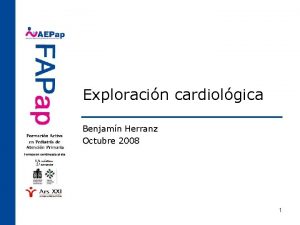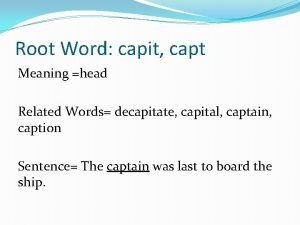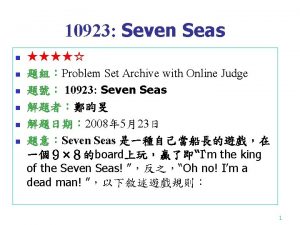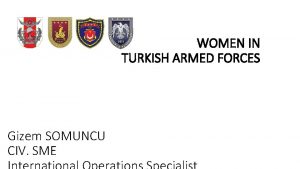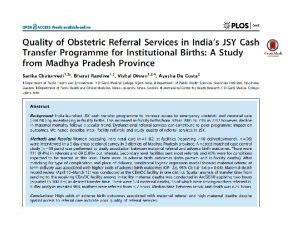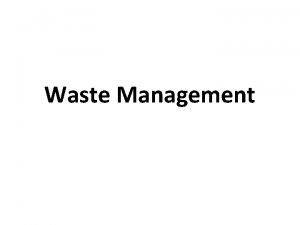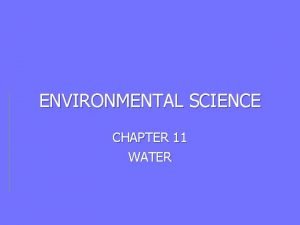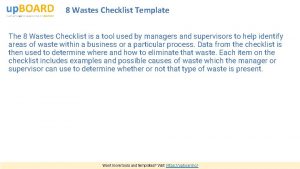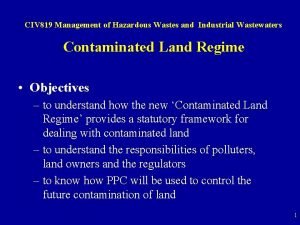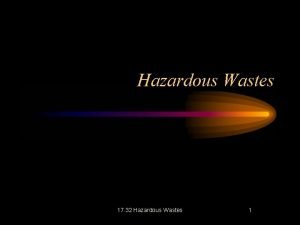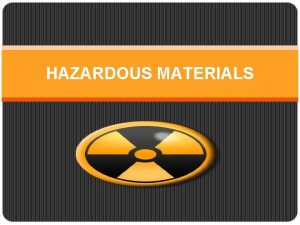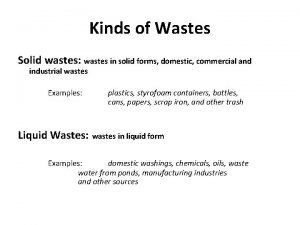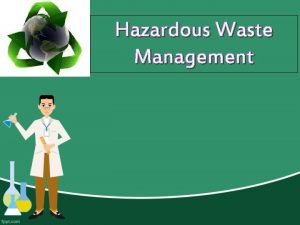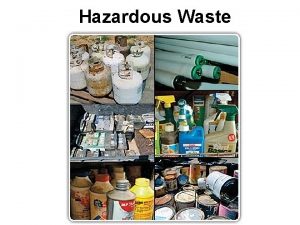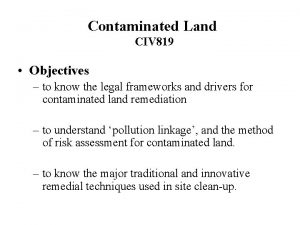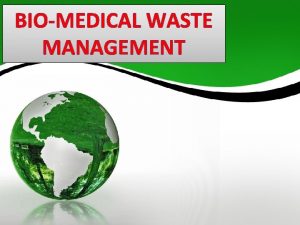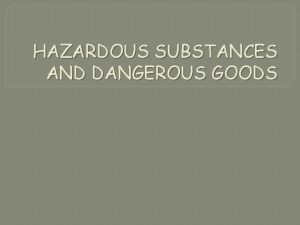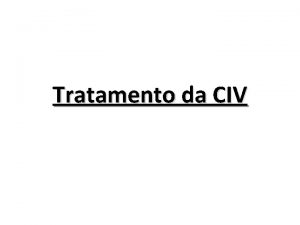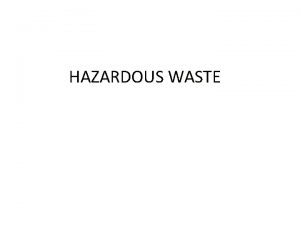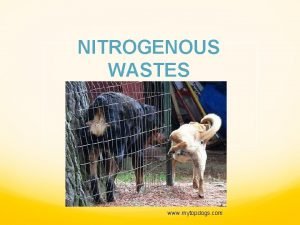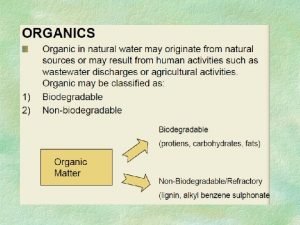CIV 819 Management of Hazardous Wastes and Industrial















- Slides: 15

CIV 819 Management of Hazardous Wastes and Industrial Wastewaters Contaminated Land Site Investigation of Contaminated Land

What is Site Investigation “ a comprehensive investigation of the site, including environmental constraints, to determine its suitability for development and to provide information which leads to safe, economical and practical designs of structures” source - CIRIA Site Investigation Manual …. . . provide sufficient information about the site to allow decisions to be made on the need for, and nature of, any immediate remedial action to protect the public and the environment. i. e. = Risk Assessment

Objectives / Information Requirements • Contamination – nature, extent, source of chemical contaminants – distribution - soil, fill, wastes, ground/surface water, air, biota – form - gas, liquid, semi-solid, solid – ground temperatures – degree of microbial activity – Health of ecosystems • Water Environment – chemical quality of water – groundwater levels / pressures, time variations – direction and flow of ground and surface water – local abstraction – propensity for flooding of site

Objectives / Information Requirements • Geotechnical – physical characteristics of the site - obstacles, services – physical characteristics of contaminated matrices mineralogy, moisture content, permeability, particle size distribution – future construction • strength, compressibility, stability of slopes, existing structures, potential for subsidence – old mine workings • Risk Related – potential receptors - investigators / workers / users / neighbours / trespassers – exposure pathways – existing and planned use of site and adjacent sites – proximity to: water bodies, sensitive ecosystems, natural resources (mineral deposits)

The Role of Site Investigations in the Remediation Process • Identification of Site • Preliminary Investigation • Planning of Investigation – possible Exploratory Investigation • Main Investigation (Detailed Investigation) • Hazard & Risk Assessment • Identification of Remedial Options • Selection of Preferred Remedial Strategy • Implementation • Validation • Long-Term Monitoring Phases

Preliminary Investigation • Desk Study – Current Layout - buildings, drains, process areas, plant, services. – Materials - feedstocks, products, wastes – History of the site • Industrial uses • previous incidents • Disposal records – Geology and Hydrology desk study information obtained from: – Maps, photographs, local history, directories, Technical Literature, Local / Government Bodies, residents, workers

Preliminary Investigation • Site Reconnaissance (Site Walkover) – External observation of acute hazards (ruptured tanks, etc) – Visual inspection for Contamination • • discoloured soil, deposits, odours, gas (detection tubes) vegetation - chlorosis, stress condition of fences, metal structures seepage through river banks, land drains – Activities on neighbouring land (on-going) – Confirms Desk Study details (e. g buildings / services/ plant location) – Produce Photographic Evidence • Planning of Subsequent Investigations – Best estimation of the extent of contamination on the site

Exploratory Investigation • Used to confirm presence of contamination where the Preliminary Investigation is inconclusive – – – – neither investigation can prove the Absence of contamination Informed sampling locations Sampling locations can form Stage 1 of the Main Investigation Composite samples Soil profile samples Restricted range of chemical analysis (targeted e. g. BTEX) helps with Planning of the Main Investigation

Main Investigation (Intrusive) • Planning – Site Access – Safety Procedures • clothing, respiratory, hygiene, confined space. • sample labelling, transport • Accident Procedure, First Aid. – Environmental Protection • dust suppression, Wheel wash, decontamination – Data Requirements • specific requirements of Regulatory bodies • sampling and analysis strategy – Long Term monitoring Requirements

Main Investigation - Sampling Strategy Requirements to be addressed: • Nature of sample – air, water soil • Sample Type and Size – spot, composite or mixed • Collection and Storage – containers, temperatures • Method of sampling – surface – augering – Trial pits and trenches – Boreholes - soil, water, gas • Depth • Pattern and Frequency of sampling

Main Investigation - Sampling Strategy Grid Size Site Size Grid Size (hectares) (m) 0. 5 10 5 20 16 30 Number Site Size Number

Main Investigation - Chemical Analysis • Quality Assurance – NAMAS • National Measurements Accreditation Service • Scope – Specific Analysis • based on Exploratory Investigation or Desk Study • Standard Suites (ICRCL) Cd Pb As Cr Zn Hg B Chloride Sulphate Sulphide Cyanide sulphur p. H Phenols Toluene extractable Matter (TEM) coal tars mineral oils PAH, PCB, BTEX

Main Investigation - Gas Analysis • In-Ground Gases – methane, hydrogen sulphide – VOC • On-site Methods – Portable Instruments (GC, IR) – Detection Tubes (Drager) – Remote Imaging (IR for methane) • Laboratory Analysis – sample collection (SSteel Gresham Tubes) – standard equipment

Remediation Objectives Remediation values are set by: • Guideline Values (e. g. Background or Threshold) • Site-Specific Risk Values for Human Health (CLEA Model, EA 1995) CS IR EF ED BW AT • Site-Specific Risk Values for Groundwater (Con. Sim EA) CONC. SOIL ING. RATE EXP. FREQ EXP. DURN. BODY WT AV TIME

Remediation Objectives The principles of Integrated Pollution Control apply to the selection of alternative Remediation Processes. These include the concepts of: • BATNEEC – Best Available Technique Not Entailing Excessive Cost • BPEO – Best Practicable Environmental Option Both “Practicable” and “Excessive Cost” are subjective terms leading to considerable flexibility in the interpretation.




